Summit 35
With blistering speed and a real interior, this IRC racer-cruiser covers all the bases
There are several things I can count on whenever I test a new Barry Carroll boat. First, the design will be intriguing and the engineering will incorporate the latest thinking and construction processes. Secondly, the boat will flat out fly. As I have written before, he has never built a slow boat and, I think I can safely say, never will. Finally, sailing with Barry and his business partner George Carabetta will be informative and a lot fun. Not surprisingly, I was delighted to have the opportunity to sail Carroll's latest offering, the Summit 35, after the recent United States Sailboat Show in Annapolis, Maryland. 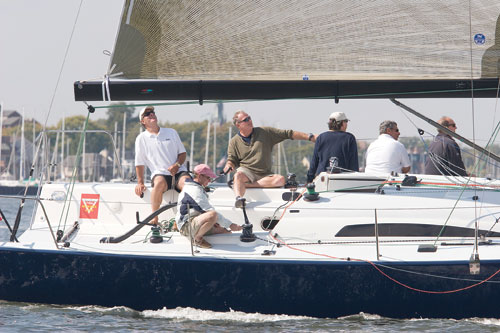
Developed from the highly successful Summit 40, also known as the King 40, the new 35 is a dual-purpose boat targeted for the IRC circuit and for swift, occasional cruising. Like the King 40, the 35 is designed by Mark Mills. According to Mills, "The Summit 35, retains the key styling and performance characteristics that made the King 40 such a success." Mills goes on to note in his design comments, "The Summit 35 should excel under IRC by combining the stability and power of a large sailplan with the low drag hull shape that permits strong all-around performance."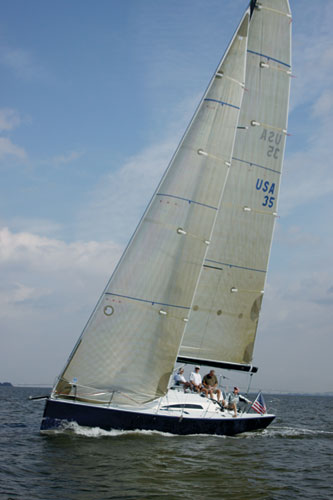
That's one the best features of the IRC; it promotes good all-around performance and allows boats of different designs to compete fairly. It promotes speed and doesn't penalize it, which makes sense. It's also a secret formula, so designers can't tweak a boat to take advantage of quirks in the rule. The IRC is very popular in Europe and gaining acceptance here. John Brim, President of US IRC, likens an IRC certificate to a passport because it allows boats from all over the world to compete under one handicapping system. An appealing aspect of the Summit 35 is that it's small enough to affordably ship to Cowes for the Commodore's Cup, and when it arrives, you know you will be racing under a rating system that's simple and fair. Good sailors and fast boats thrive under the IRC.
The details
The Summit 35 features long ends, plenty of freeboard, a sleek, sloping cabintrunk and substantial beam carried well aft. The 35 is slightly beamier at the waterline than the 40, adding more form stability. The boat is no lightweight. The displacement is nearly 11,000 pounds, and, with half of that in ballast, the 35 is stiff. In fact, the ballast is a lead bulb attached to the bottom of a deep fin keel, in effect putting the pounds exactly where you need them. The high-aspect rudder is proportionately huge, which accounts for the 35's pinpoint steering. The fractional rig is generous with 704 square feet of sail area. 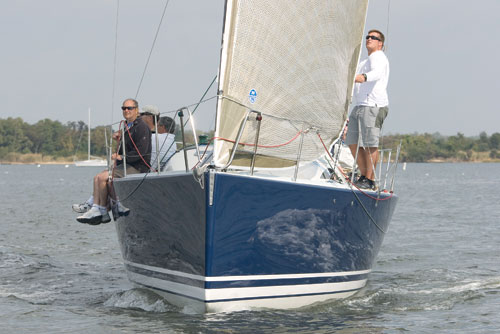
I really like this design premise. The 35 is a fast, stable boat that can stand up to a blow. It also has a sailplan and hull shape to be fast in light air and to keep momentum through a chop when the breeze has faded but the seas still linger. The hull may pound a bit driving upwind but the moment you crack off you'll feel the boat soar. Trust me, this is the hull shape we'll be looking at for awhile.
Carroll and Carabetta have shifted construction back to the United States from Buenos Aires.
"King Marine built great boats but we had some logistical issues in Argentina," Carroll said, explaining why both the Summit 35 and 40 are now being built by Edgewater Boats in North Florida. A stateside location makes sense from a production and transport perspective. Beyond that, it's refreshing to see that state-of-the-art sailboats can be built in the United States and priced competitively. Is this a sign of the rebirth of the American sailboat industry? As we continue to shift from large production runs to high-quality semi-custom built boats there is no reason why American builders can't lead the way.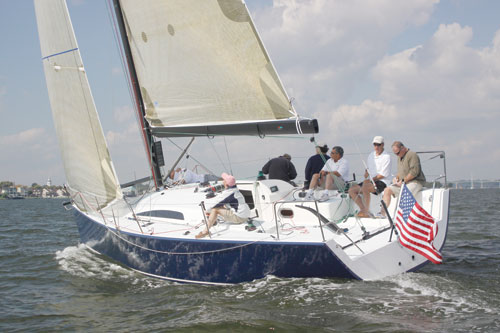
The Summit 35 hull is a composite construction with E-glass, core cell foam and vinylester resins. The primary bulkheads are also composite and bonded through 360 degrees. An immensely strong anodized aluminum structural grid in the bilge supports the keel. This metal footprint is a terrific way to spread the loads generated by a deep, narrow-chord, high-aspect keel, especially in a grounding situation when the keel bolts are stressed before loads transfer. The iron keel itself is lighter than an equivalent all-lead keel and can be shaped into a cleaner foil shape. And as noted earlier, the lead is where you want it, in a bulb bolted to the very bottom of the keel. The bulb itself is an efficient hydrodynamic shape that lowers drag and tip loss. The faired rudder blade is built around a high-strength, ultralight, carbon fiber stock. More and more builders are using carbon fiber for rudder stocks, but that doesn't mean that I have to like them. I have a sailor's classic conservatism when it comes to steering systems, I can't help myself. 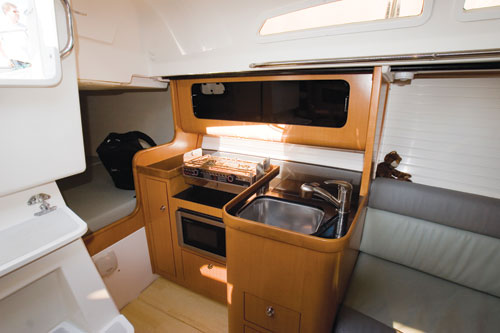
The first thing you'll notice about the Summit 35, aside from its sleek lines, is the black carbon fiber tiller that gives the cockpit a stealthy, small boat look. When I asked George, "Why a tiller?" he quickly assured me that twin carbon wheels were an option. Just as quickly I told him that given the choice I'd opt for the tiller. It's hard to beat the feeling of steering a fast, powerful boat with a beautifully balanced tiller. The rudder is in your hand. The concept of lift suddenly seems to make sense. This is what sailing was meant to be. Of course wheels are an option, but I wouldn't recommend them.
On deck
Mills has designed a brilliant cockpit. It is T-shaped with two short seats, but it's really a cockpit designed for working the boat. That doesn't mean that you need a crew. The Summit 35 is set up for easy short-handed sailing, especially with a tiller extender that gives you more options on where to sit or stand while steering. 
Sail controls are led aft, naturally, through Spinlock clutches to Harken 40.2 self-tailing winches perched on the cabintrunk. Winches and most deck hardware is Harken. The primaries are 44.2s and the secondary winches are another pair of 40.2s. The mainsheet, the headsail sheets and the traveler controls are led under the deck. This arrangement keeps line clutter under control. The serious bridgedeck is a requirement of the European CE Category A standard for offshore sailing.
The traveler is aft, setting up an efficient end-boom sheeting arrangement. The traveler controls are easy to reach from the tiller, coming up from blocks through the sole. Coming about when it's blowing it's important to be able to the dump and trim the traveler in a hurry. There are two well-placed foot supports that also do a nice job of providing a housing for the traveler control lines. The open transom can be secured with two lifelines. Although at first you can feel a bit exposed, once you become accustomed to the open cockpit you will appreciate the space and access to every corner of the boat. 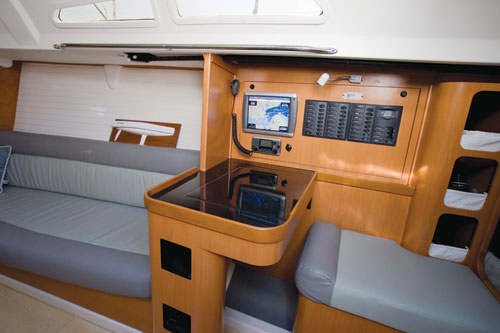
The spars are aluminum, an interesting choice instead of carbon, and the standing rigging is discontinuous stainless steel rod. Carroll explained that aluminum spars really keep the overall cost down and also help with the IRC rating. The boom has an 8:1 internal outhaul led aft. The vang has 16:1 purchase; you can do a lot with the boom. Our test boat was fitted with the optional push-button hydraulic backstay adjuster. Although synthetic standing rigging was featured on several boats at the show, Carroll is not ready to go there just yet.
It's an easy step from the cockpit seats to the side decks. The nonskid is aggressive and it needs to be because there are no handholds on deck. Up forward there is a retractable carbon fiber sprit that's easy to deploy. The retractable cleats are a nice feature as they eliminate points for lines to hang up on the foredeck.
Down below
While the term dual-purpose gets tossed about loosely these days, the Summit 35 has a "real" interior. And like the exterior, it's thoughtfully laid out and nicely executed. Can you name another 35-foot performance boat with three double berths? Once you drop below you will find a double quarter cabin to port and starboard. These bunks are great storage areas and also good spots to sleep underway. 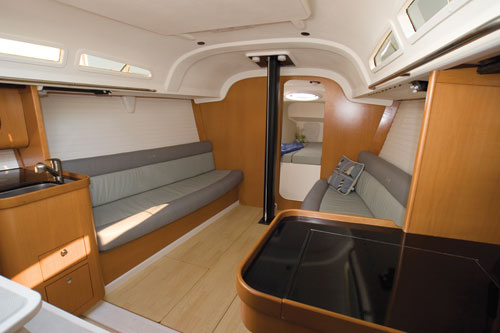
The engine is squeezed between the two cabins and accessed from behind the stairs. It's a 28-horsepower Volvo diesel with a saildrive. It also has a 115-amp alternator to maximize battery charging during the rare time when you will need to motor. The 17-gallon fuel tank will likely last you a full season. A two-blade folding prop is standard, although I think I'd opt for the optional Gori feathering prop.
Back to the interior, the galley is to port. The counters are black synthetic. They're light, have serious fiddles and look great. A small two-burner, non-pressurized Origo alcohol stove is standard. A single sink is on the centerline and a decent-size icebox is forward of the stove. There's storage above the stove in a bin with a Plexiglas cover and below it in draws. The navigation center is opposite. The electrical panel is outboard and there's storage in bins and inside the chart table.
The saloon features straight settees port and starboard and both make good sea berths. Continuing forward, the head spans the boat and is closed off with a bi-fold door. The V-berth includes another double berth but I suspect it will often be used for sail stowage. The composite bulkheads are trimmed in light wood veneers and molded pieces are used throughout. The bright white finish of the fiberglass gives the boat a sense of light and spaciousness.
Under sail
Now it was time to sail the boat. Working our way into deep water the wind was beginning to build. We put the boat through several quick tacks as we headed north toward the Bay Bridge. It took a few tacks before I stopped oversteering; to say the Summit 35 is responsive is an understatement. The acceleration was impressive as we quickly gained way after each tack. We had a spanking new set of North 3DL sails aboard. Each owner specs out his or her own sails but I suspect 3DLs will be popular on most of the Summit 35 fleet.
Soon we had enough sea room to set the spinnaker. The Summit 35 has both a three-quarter and masthead spinnaker halyards. We set it from the masthead and took off. The northwest wind was true at 11 to 12 knots and our speed over the bottom was in the high 8s. With a few puffs we heated things up and surged to more than 9 knots. The ride was rock steady, there was not a hint of squirrelly-ness. And the tiller was light.
After charging back toward Annapolis, we blanketed the kite with the main, and quickly pulled up the jib once again. Sailing on a close reach we shot past several other new boats out on test sails. Barry and George did their best not to gloat but you could see from the glint in their eyes they knew they had another winner.

Comments